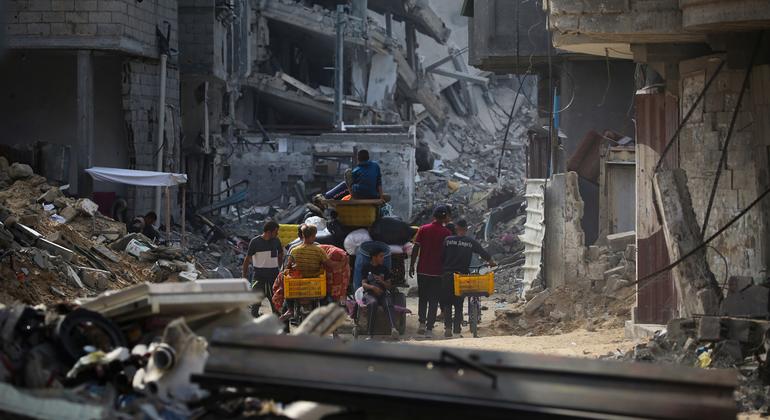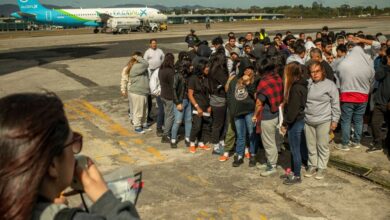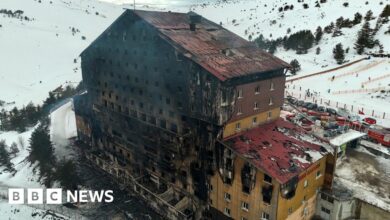Back to ‘hell’: An aid worker’s journey through devastated Gaza


“You can hear the bombs from the north, the middle and the south… Gaza is really hell on earth right now, it’s very hot… There’s rubbish piled up everywhere, people are living under plastic sheets where the temperatures are soaring,” said Ms Wateridge, a senior communications officer for the UN agency for Palestinian refugees. UNRWAhours after returning to a land ravaged since terrorist attacks and hostage takings led by Hamas last October sparked the war.
After arriving on Thursday through the Kerem Shalom crossing in the southernmost part of Gaza, Ms Wateridge said what she saw in nearby Rafah was “destroyed”. The city was her base during her first visit in May, when Israeli forces seized the key border crossing, further hampering aid deliveries into Gaza.
Scenes of devastation were repeated on the aid worker’s journey north to central Gaza, where she now lives.
Empty house shells serve as shelter
“The drive through Khan Younis was shocking – I hadn’t been there since before the Rafah invasion on 6 May and it was a ghost town because everything was destroyed.”
“Now, there are many families living inside these destroyed skeletal buildings. People have spread blankets or plastic sheets over places where walls were blown away. So the difference between the invasion of Rafah and the ongoing military action is clearly visible.”
Lawlessness and looting
UNRWA staff confirm reports of a breakdown of law and order after nearly nine months of intense Israeli bombing that has disrupted normal life in Gaza and forced people to stop aid trucks to search. food as they passed through Gaza via Kerem Shalom.
“The road was full of looters when we arrived. We arrived at the same time as some aid trucks, so there were hundreds of armed men waiting for them to arrive. The trucks we passed on the road were all badly damaged – the windscreens were completely smashed, they all had metal bars reinforced around the driver’s area. It felt completely lawless.”
‘Every single building’ of the UN was damaged or destroyed
Going deeper into Gaza, Ms. Wateridge described the damage caused to United Nations facilities on the road from Kerem Shalom to Khan Younis, Deir al Balah and beyond, some of which were riddled with large holes from artillery. jack and some others were destroyed and damaged by the weather.
“Every UNWRA facility – schools, warehouses, food distribution, etc. – was significantly damaged or even destroyed. Bullet holes, exploding walls, floors collapsing like pancakes on top of each other – you wouldn’t know that these are United Nations facilities protected by international law.”
According to the United Nations Office for the Coordination of Aid, (OCHA), since the beginning of 2024, only 14% of the fuel (diesel and benzene) that used to enter Gaza monthly before October 2023, has been allowed into the area (two million liters compared to 14 million liters).
“We have no fuel so we can’t go anywhere – it’s all humanitarian,” said Ms Wateridge, confirming that aid operations continue to be hampered by difficulties getting fuel from Kerem Shalom. “For UNRWA, there are plans to distribute what we have – food and mattresses – but it’s very limited. It’s another testament to how bad the humanitarian response is when we don’t even have enough fuel to move.”
In addition to these challenges, UNRWA staff also face their own problems, Ms. Wateridge explained. “I look forward to meeting them; They were okay, but they were very hurt because they had to leave Rafah. Now they have nothing left.”



